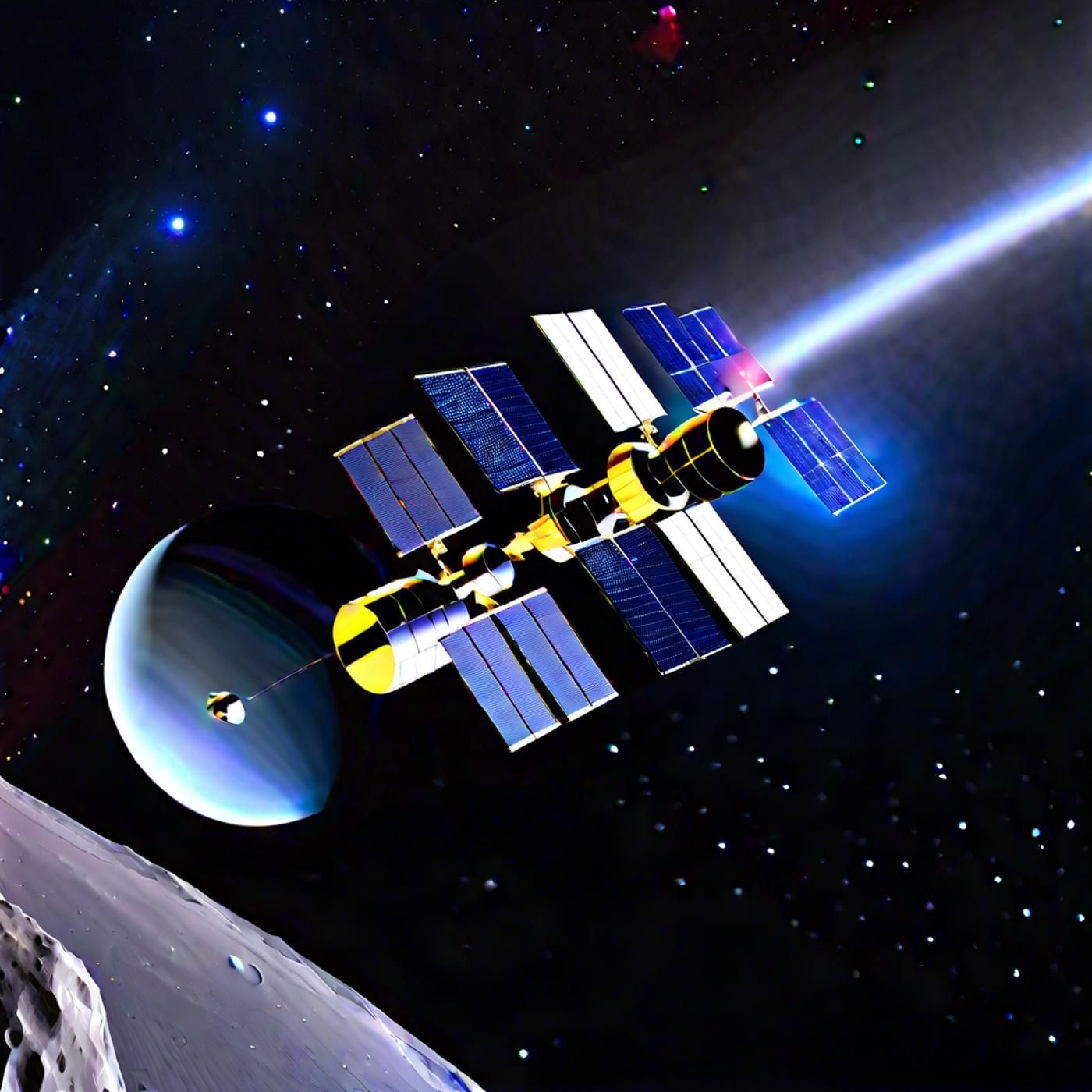S03E50: Pre-Fire Pioneers & Lithuanian Leap: Charting New Climate & Cosmic Courses

Prepare for a cosmic odyssey on today's episode of Astronomy Daily - The Podcast, with your starry-eyed guide, Anna. Today's journey takes us from the frozen frontiers of our own planet to the far reaches of the solar system and beyond.
We'll launch...
Prepare for a cosmic odyssey on today's episode of Astronomy Daily - The Podcast, with your starry-eyed guide, Anna. Today's journey takes us from the frozen frontiers of our own planet to the far reaches of the solar system and beyond.
We'll launch into the pioneering PRE-PhIRE mission, where twin cubesats aim to revolutionize our understanding of Earth's climate by studying its polar regions. Then, we'll celebrate Lithuania's leap into the Artemis Accords, joining a global coalition dedicated to peaceful and cooperative space exploration.
Next, we glide over Europa's icy shell with NASA's Juno, unveiling landscapes that may hide an ocean beneath, and ponder the existence of life on Speculoos-3b, an Earth-sized exoplanet orbiting an ultra-cool dwarf star. Finally, we'll navigate the challenges faced by the BepiColombo mission as it perseveres on its ambitious journey to Mercury.
1. **Polar Pioneers**: Discover how PRE-PhIRE's cubesats will shed light on Earth's climate mysteries.
2. **Artemis's New Ally**: Lithuania's commitment to a future of collaborative space exploration.
3. **Europa's Icy Enigma**: Juno's close encounter with Jupiter's moon reveals a dynamic world.
4. **Speculoos-3b's Stellar Secrets**: Exploring the potential for life around red dwarf stars.
5. **BepiColombo's Power Struggle**: The mission's technical challenges on its voyage to Mercury.
Join us as we traverse the cosmos, unraveling the stories etched in the stars. For an immersive experience of the universe, visit our website at astronomydaily.io, and join the conversation on X (@AstroDailyPod) for daily updates and celestial camaraderie.
Until our next galactic gathering, this is Anna reminding you to keep your eyes on the skies and your sense of wonder ignited. Clear skies and cosmic curiosity to all our fellow space enthusiasts!
This episode is brought to you with the support of our stellar sponsors, including NordPass, the password manager that's as essential as a telescope for stargazing. Discover our exclusive offer at www.bitesz.com/nordpass and explore more sponsor deals on our website.
Become a supporter of this podcast: https://www.spreaker.com/podcast/astronomy-daily-the-podcast--5648921/support.
NASA launching twin polar satellites to revolutionize our knowledge of Earth's climate
Anna: Welcome to Astronomy Daily, the podcast with your host, Anna. Today we delve into the latest and most fascinating astronomy news, exploring the final frontier and the astronomical marvels awaiting us beyond our blue planet. From twin polar satellites set to revolutionize our knowledge of Earth's climate, to Lithuania's leap into the Artemis accords, paving the way for safer space exploration, well, gaze upon the icy shells of Europa through Juno's lens and marvel at an Earth sized world twirling around an ultra cool star. Lastly, we'll uncover the challenges faced by the ambitious bepicolombo on its journey to Mercury. Join us as we traverse through the cosmos and uncover the stories written in the stars. Execute audio the Astonomy Daily podcast in the realm of space exploration and Earth science, NASA is once again pushing the boundaries of what we know about our own planet's climate. Upcoming is the launch of the innovative pre fire mission, set to deploy a pair of tiny but remarkably capable twin satellites. These shoebox sized cubesats are going on a crucial journey to the most remote and inhospitable regions on Earth, the polar regions. There's something quite compelling about these modest spacecraft, as they carry the enormous responsibility of measuring the extent to which these icy regions contribute to the global energy budget, a key component in understanding our planet's climate patterns. In an age where accurate climate predictions are more important than ever, pre fire's data will be pivotal. It will offer insights into the greenhouse effect, particularly around the poles, where changes are most pronounced but insufficiently measured. By measuring far infrared energy radiated into space, these cubesats will fill in critical gaps in our climate knowledge base. They're equipped with advanced thermal infrared spectrometers sensitive to an array of infrared wavelengths far greater than those of previous instruments. This sensitivity will enable pre fire to paint a more precise picture of the Arctic and antarctic contributions to the earth's heat emissions. Moreover, pre fire is not just another Earth studying mission. It is a mission with heart, fostering the growth of a new generation of climate scientists. Developed in collaboration with universities, it provides a platform for students at the undergraduate and graduate levels to dive headfirst into into the science that will shape the future of climate policy and research. As pre fire satellites orbit Earth, they'll perform a sort of polar detective work, deciphering clues about why the Arctic has been warming at a rate that is more than twice the global average since the 1970s. This mission stands as a testament to NASA's commitment to pushing the envelope of satellite technology, showing that even the smallest among us can carry the weightiest of tasks, guiding humanity into a future where we better understand the forces shaping our earth's climate.
The Artemis Accords, a beacon of cooperation in space exploration, welcomed new member
The Artemis Accords, a beacon of cooperation in space exploration, have recently welcomed a new member. With the inclusion of Lithuania as the 40th nation to sign these accords, the international coalition, led by NASA, embarks on an even broader mission to foster safety and peace beyond our terrestrial borders. This milestone solidifies our collective commitment to exploring the cosmos in a responsible and transparent manner. The Artemis accords themselves are not just a set of guidelines. They reflect our aspiration to ascend together in harmony. Rooted in the principles of the historic Outer Space Treaty of 1967, these accords are designed to encourage peaceful exploration, prevent conflict, and ensure that all activities conducted in space are for the benefit of all humanity. As Lithuania joins the Artemis family, their pledge to uphold these ideals echoes through the vastness of space. At the signing ceremony held in Vilnius, the sense of unity was palpable. Leaders and dignitaries, including NASA administrator Bill Nelson and United States Ambassador Kara C. MacDonald, celebrated not just an agreement on paper, but a symbolic handshake across the cosmos. Nelson expressed his optimism about this growing partnership, stating, together as a global coalition, we will explore the stars openly, responsibly, and in peace. Lithuania's minister of economy and innovation, Osrin Arminate, further underscored the significance of this alliance, recognizing that the Artemis accords chart a new course for the future of space exploration. Indeed, the Artemis program itself aims high, preparing to send astronauts back to the moon, including the first woman and first person of color. These bold steps serve as the groundwork not just for lunar exploration, but also set the stage for the eventual human journey to Mars. Lithuania's joining is a clear message. Exploration is a collaborative effort. And as we stand at the dawn of what NASA deputy administrator Pam Melroy calls the golden age of space, it's exhilarating to know that we go forward together. The days of solitary space exploration are behind us now. We embrace the power of partnership, of shared dreams and achievements. It's a reminder that our destiny among the stars isn't just written by one, but by many, working side by side for a future that inspires us all.
NASA's Juno spacecraft makes close flyby of icy moon Europa
Jupiter's moon Europa has long captivated scientists and space enthusiasts alike with its icy surface and the potential for a subsurface ocean. The intrigue deepened when NASA's Juno spacecraft made a daring close flyby. Skimming just 220 miles above Europa's enigmatic ice. This marked the nearest approach and the highest resolution observation since the Galileo mission over two decades earlier. Europa's icy shell dazzles with complex patterns hinting at the turbulent dance of shifting ice upon an ocean we have yet to see. Juneau's images showcase not just the expected ridges and troughs, but also steep walled depressions spanning up to 31 miles wide. These features fuel the theory of true polar wander, suggesting that Europa's outer shell might be floating atop its internal ocean, occasionally shifting and rotating as a whole. The term true polar wander sounds poetic, almost as if it's from a celestial fairy tale. But in geological terms, it signifies a grand process of planetary movement. Reshaping the moon's icy facade. Juno's findings are painting a picture where enormity meets intricacy, a place where colossal blocks of ice are displaced over epochs, carving out a landscape that speaks of the forces beneath. But Europa does not surrender its secrets easily. There are signs, faint yet provocative, suggesting Europa might harbor plume activity. Eruptions of water vapor through fractures in the surface. Juno's stellar reference unit, a camera designed to capture the faint glow of stars for navigation, was repurposed ingeniously to capture the night side of Europa, with only the dim Jupiter shine illuminating its features. This view highlighted intricate ridge networks and dark, potentially plume borne stains. Amid this alien ice, frozen in time, Junocam identified the platypus terrain. This especially jumbled and broken area of ice, about the size of a small city, is one of the youngest formations in its vicinage. Its curiously disrupted terrain, scattered with ice blocks, may testify to the presence of sweeping liquid water close to Europa's surface. Each data packet we receive from Juno, each pixel of Europa gleaned in these high definition observations, brings us one step closer to understanding the dynamics of this icy world. How does a celestial body encased in a frozen shell manage to churn and evolve? How do hidden oceans influence the frigid topography? What does this tell us about the potential for life in environments far different from those on our earth? As we peer through Juno's electronic eyes, every shadow hints at an untold story, every light pattern a piece of the enigmatic puzzle. So as Juno continues to orbit the gas giant, keep your eyes on the stars, for revelations about Europa. Like stars above, a winter's night are emerging slowly but surely, reshaping our understanding of the solar system's hidden marine world.
Speculus three b is an Earth sized exoplanet orbiting an ultra cool dwarf star
The astronomer daily podcast in a galaxy filled with the glimmer of myriad stars, there's a particular sapphire that shines with a distinct allure. This blue jewel is none other than the Earth sized exoplanet named speculus three b, a celestial marvel orbiting what is known to astronomers as an ultra cool dwarf star. The significance of this discovery cannot be overstated, as it promises to unlock many secrets concerning the potential habitability around the red dwarfs. The most common stellar inhabitants of our milky m way imagine a world not unlike our own in size. Yet its year, an orbit around its star is a mere 17 hours long. Can you fathom a sky where day and night are perpetually fixed, one face of the planet basking in endless twilight while the other remains shrouded in eternal night? This could be the reality for speculus three b, theorized to be tidally locked to its star, much like the moon is to Earth. Amid its overwhelming abundance. What makes the ultracool dwarf stars truly fascinating is their gentle touch. Although they emit a faint glow much dimmer than our fiery sun, they can barrage their orbiting planets with potent radiation, especially during their early years. Yet these stars are also known for their longevity. While our sun has a life expectancy of around 10 billion years, red dwarfs can continue to burn over 100 billion years, thereby offering what might be an enduring opportunity for life to emerge and evolve. The discovery of Speculus three b was made possible by a dedicated international team wielding the might of robotic telescopes from around the globe. A suite of these high tech eyes, named after the famous belgian shortbread, Speculus, now feast on the sky, meticulously exploring our ubiquitous yet little understood cosmic neighbors. Searching for promising planetary bodies capable of harboring life, this red dwarf and its accompanying world were found to be a mere 55 light years away within our cosmic backyard. While the star's chilly demeanor, at a few thousand degrees cooler than our sun, suggests a more temperate environment, the proximity of Speculus three b to its star subjects it to formidable radiation, likely stripping it of any atmosphere if one ever existed. The shiny future of exoplanet research beckons all those who gaze up at the night sky in wonder. As we look toward instruments like the James Webb Space Telescope and upcoming missions, we stand at the threshold of a new era. Speculus three b, along with its ultracool star, holds keys to unfathomable questions about the cosmos, illuminating possibilities of life beyond our solar embrace. In our ongoing exploration of the solar system, missions like Bepicolombo are vital in enhancing our understanding of the planetary dynamics and conditions far from Earth. The joint mission between the European Space Agency and the Japan Aerospace Exploration Agency aims to unlock the secrets of Mercury, the innermost planet of our solar system. However, this ambitious interplanetary odyssey recently encountered an unforeseen challenge. On April 26, the Bepicolombo team discovered that the spacecraft's transfer module was failing to provide sufficient electrical power to the thrusters, a key component for the spacecraft's journey to Mercury. Though designed to thrust with precision through the deep void of space, Bepicolombo now faces a significant hurdle. Operating at diminished power and thus compromising its full maneuverability, an exceptional team of engineers and scientists from ESA, together with their industrial partners, are engaged in a race against time, working diligently to resolve the issue. By May 7, their relentless efforts had succeeded in increasing the mission's propulsion capacity to approximately 90% of the desired level. Yet the quest for a complete restoration of full thrust continues. It's a complex task that involves maintaining the spacecraft's stable propulsion at the current power level, understanding the intricacies of the problem, and devising strategies to enhance the energy supply to the thrusters. The competence of the Bepicolombo flight control team, stationed at ESA's ESOC Mission Control center in Darmstadt, Germany, is put to the test as they closely monitor the spacecraft with additional ground station time, ensuring an immediate response to any subsequent developments. As we await further updates on this intricate technical ballet, we remain hopeful that Bepicolombo will keep its scheduled rendezvous with mercury for its fourth gravity assist in September this year, leading to the anticipated orbit insertion in December 2025, followed by a spring 2026 start for routine science operations. Bepicolombo's trial is a stark reminder of the unpredictability of space exploration. Yet it is through such challenges that we advance our technological prowess and deepen our cosmic perspective. The resilient spirit of collaboration between ESA and JAXA exemplifies our collective endeavor to push the boundaries of human knowledge amidst the grandeur of space. Thank you for joining us on Astronomy daily, the podcast remember to visit astronomydaily IO for past episodes and the latest space news. Sign up for our free daily newsletter or get in contact. Catch a star's Twinkle in articles, or listen to the silent music of the Cosmos in podcast episodes that take you beyond the horizon. For a more interactive celestial journey, follow us on X formally known as Twitter AstroDailyPod connect with a community that looks up and muses over the wonders above. Until next time, keep your eyes to the skies and your curiosity alight. This is Anna signing off.
New to Astronomy Daily - The Podcast?
Here are some great episodes to start with.



















